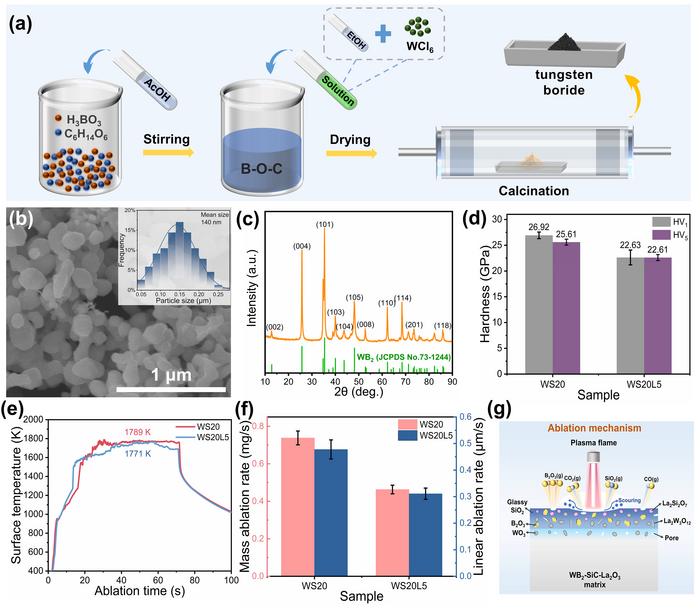
In a groundbreaking advancement in the field of ultra-high temperature ceramics (UHTCs), a research team led by Professor HUANG Zhulin at the Institute of Solid State Physics, part of the Hefei Institutes of Physical Science under the Chinese Academy of Sciences, has successfully synthesized novel tungsten-based ceramics exhibiting exceptional mechanical strength and resistance to ablation. Their findings, recently published in the prestigious Journal of the European Ceramic Society, mark a significant stride toward enhancing the performance and durability of materials critical for thermal protection systems exposed to extreme environments.
UHTCs have long been recognized for their remarkable ability to withstand temperatures beyond 2000°C, making them indispensable for applications such as aerospace heat shields, hypersonic vehicles, and nuclear reactors. Among these materials, tungsten-based ceramics have attracted particular interest due to tungsten’s inherently high melting point and excellent resistance to thermal radiation. However, traditional tungsten carbides and borides have faced persistent challenges, including grain growth during sintering that compromises mechanical integrity, difficulties in achieving full densification, and limited ability to resist oxidation and surface erosion under extreme thermal stress.
Addressing these limitations, the research team employed an innovative liquid-phase precursor synthesis method to fabricate high-purity WC-xTaC and WB₂ ceramic powders. The introduction of tantalum carbide (TaC) as a grain growth inhibitor emerged as a key strategy to suppress excessive coarsening of tungsten carbide grains during sintering. This approach enabled the production of binder-free WC ceramics with a remarkable densification rate of 97.8%, yielding materials with a nanoscale grain structure that contributes to an exceptional hardness value reaching 24 GPa. Such hardness levels position these ceramics among the hardest known without sacrificing toughness.
Simultaneously, the team focused on tungsten boride (WB₂)-based composites, wherein they incorporated silicon carbide (SiC) as a sintering aid to facilitate densification. This tailored composite, labeled WS20, demonstrated a densification of 98.2% and an exceptional hardness of 26.9 GPa, surpassing conventional tungsten-based ceramics. The synergy between WB₂ and SiC not only improved sintering kinetics but also contributed to enhanced mechanical stability, which is crucial for thermal barrier applications subjected to repeated heating cycles and mechanical stresses.
To push the boundaries of ablation resistance, an essential property for materials facing rapid heating and oxidation during high-velocity flight or plasma exposure, the team introduced lanthanum oxide (La₂O₃) into the WB₂–SiC matrix. The resulting composite, WS20L5, was tested under an intense plasma flame maintained at 2273 K, mimicking extreme aerospace thermal environments. Remarkably, this material exhibited a mass ablation rate of only 0.463 mg/s and a linear ablation rate of 0.311 μm/s, metrics that are comparable to the performance of traditional zirconium- and hafnium-based UHTCs renowned for their durability.
Detailed mechanistic studies revealed that La₂O₃ plays a transformative role in the composite’s ablation resistance. At elevated temperatures, La₂O₃ reacts with the naturally formed silicon dioxide (SiO₂) layer to generate lanthanum disilicate (La₂Si₂O₇). This phase is critically important because it effectively captures boron oxide (B₂O₃), a volatile component prone to evaporation at high temperatures, thereby reducing volatile losses that can degrade the ceramic’s protective layers. Furthermore, during ablation, a glassy layer composed of B-Si-O-La compounds forms on the surface of the composite. This vitrified phase acts as an impermeable sealant, filling surface pores and creating a formidable barrier against oxygen ingress, which fundamentally enhances the ceramic’s oxidation resistance and prolongs operational lifetime.
These findings represent a vital leap in our understanding of how compositional tuning and microstructural engineering can synergistically advance the performance envelope of tungsten-based UHTCs. By strategically doping the ceramic matrix and designing composites with tailored interfaces, the research team has outlined a clear pathway toward developing materials capable of enduring some of the harshest thermal and oxidative environments known in engineering.
Beyond their immediate application in aerospace and defense sectors, these optimized tungsten-boride and tungsten-carbide ceramics hold promise for a myriad of industrial uses requiring high wear resistance and thermal stability, such as cutting tools, refractory components, and nuclear fuel claddings. Moreover, the methodology pioneered here offers a scalable route for manufacturing advanced ceramics with controlled microstructures, which could accelerate the deployment of ultrahigh temperature materials across various high-tech fields.
Professor HUANG and the team emphasize that the interplay between grain boundary engineering, dopant chemistry, and protective oxide formation is key to overcoming longstanding obstacles in UHTC development. Their success with La₂O₃-Stabilized WB₂-SiC composites opens exciting avenues for further research, particularly in exploring other rare-earth oxides and composite formulations to tailor performance for specialized operating conditions.
As the aerospace industry pushes the envelope of hypersonic travel and space exploration, materials capable of withstanding extreme thermal loads without compromising mechanical integrity are indispensable. This research not only expands the material palette available for such technologies but also deepens the fundamental scientific knowledge necessary to innovate next-generation thermal protection systems.
Looking ahead, continued investigations into the dynamic responses of these tungsten-based ceramics under cyclic thermal loading, combined with real-world application testing, will be essential to translating laboratory success into deployed solutions. The integration of advanced characterization techniques and modeling will further elucidate the complex phenomena governing ablation and sintering behaviors at the atomic scale.
In summary, the study led by Professor HUANG offers a compelling demonstration of how targeted material design, informed by an understanding of phase behavior and microstructural evolution, can unlock new levels of performance in refractory ceramics. These results stand to influence the trajectory of UHTC research and their application in cutting-edge technologies, heralding a new era of materials engineered for both strength and resilience under the most punishing conditions imaginable.
Subject of Research: Tungsten-based ultra-high temperature ceramics with enhanced mechanical properties and ablation resistance
Article Title: La2O3 stabilized WB2-SiC composites with remarkable ablation resistance up to 2273 K
News Publication Date: 18-Feb-2025
Web References: http://dx.doi.org/10.1016/j.jeurceramsoc.2025.117298
Image Credits: HU Mengen
Keywords
Physical sciences
Tags: advanced tungsten ceramicsaerospace heat shieldsgrain growth in ceramicsHefei Institutes of Physical Sciencehigh melting point ceramicshypersonic vehicle materialsliquid-phase precursor synthesismechanical strength and ablation resistanceoxidation resistance in extreme environmentsthermal protection systemstungsten-based materialsultra-high temperature ceramics





